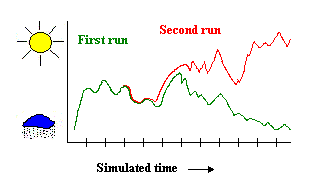Online Course
NRSG 696 - Leadership Analysis Cinematic
Module 1: Leadership and World War II
Chaos Theory
One of the main reasons we need leaders is that we live in a chaotic world. Remember Jurassic Park? Handsome mathematician Doctor Malcom explaining to pretty Doctor Sattler why he thought it was unwise to have T-rexes and the likes romping around on an island? John Hammond, the annoying owner, promised that nothing could go wrong and that all precautions were taken to ensure the safety of visitors.
Dr. Malcom did not agree. "Life finds a way," he said. (Click here to see the clip!!)
Nature is highly complex, and the only prediction you can make is that she is unpredictable. The amazing unpredictability of nature is what Chaos Theory looks at. Why? Because instead of being boring and translucent, nature is marvelous and mysterious. And Chaos Theory has managed to somewhat capture the beauty of the unpredictable and display it in the most awesome patterns. Nature, when looked upon with the right kind of eyes, presents herself as one of the most fabulous works of art ever wrought.
Chaos Theory is a mathematical sub-discipline that studies complex systems. Examples of these complex systems that Chaos Theory helped fathom are earth's weather system, the behavior of water boiling on a stove, migratory patterns of birds, or the spread of vegetation across a continent. Chaos is everywhere, from nature's most intimate considerations to art of any kind. Chaos-based graphics show up all the time, wherever flocks of little space ships sweep across the movie screen in highly complex ways, or awesome landscapes adorn the theater of some dramatic Oscar scene.
Complex systems are systems that contain so much motion (so many elements that move) that computers are required to calculate all the various possibilities. That is why Chaos Theory could not have emerged before the second half of the 20th century. But there is another reason that Chaos Theory was born so recently, and that is the Quantum Mechanical Revolution and how it ended the deterministic era!
Up to the Quantum Mechanical Revolution people believed that things were directly caused by other things, that what went up had to come down, and that if only we could catch and tag every particle in the universe we could predict events from then on. Entire governments and systems of belief were (and, sadly, are still) founded on these beliefs, and when Sigmund Freud invented psychoanalysis, he headed out from the idea that malfunctions in the mind are the results of traumas suffered in the past. Regression would allow the patient to stroll down memory lane, pinpoint the sore spot and rub it away with Freud's healing techniques that were again based on linear cause and effect.
Chaos Theory however taught us that nature most often works in patterns, which are caused by the sum of many tiny pulses. It all started to dawn on people when in 1960 a man named Edward Lorenz created a weather-model on his computer at the Massachusetts Institute of Technology. Lorentz' weather model consisted of an extensive array of complex formulas that kicked numbers around like an old pig skin. Clouds rose and winds blew, heat scourged or cold came creeping up the breeches.
Colleagues and students marveled over the machine because it never seemed to repeat a sequence; it was really quite like the real weather. Some even hoped that Lorentz had built the ultimate weather-predictor and if the input parameters were chosen identical to those of the real weather howling outside the Maclaurin Building, it could mimic earth's atmosphere and be turned into a precise prophet.
But then one day Lorentz decided to cheat a little bit. He had let the program run on certain parameters to generate a certain weather pattern and he wanted to take a better look at the outcome. But instead of letting the program run from the initial settings and calculate the outcome, Lorentz decided to start half way down the sequence by inputting the values that the computer had come up with during the earlier run.

The computer that Lorentz was working with calculated the various parameters with an accuracy of six decimals. But the printout gave these numbers with a three decimal accuracy. So instead of inputting certain numbers (like wind, temperature and stuff like that) as accurate as the computer had them, Lorentz settled for approximations; 5.123456 became 5.123 (for instance). And that puny little inaccuracy appeared to amplify and cause the entire system to swing out of whack.
Exactly how important is all this? Well, in the case of weather systems, it's very important. Weather is the total behavior of all the molecules that make up earth's atmosphere. And in the previous chapters we've established that a tiny particle cannot be accurately pin-pointed, due to the Uncertainty Principle! And this is the sole reason why weather forecasts begin to be bogus around a day or two into the future. We can't get an accurate fix on the present situation, just a mere approximation, and so our ideas about the weather are doomed to fall into misalignment in a matter of hours, and completely into the nebulas of fantasy within days. Nature will not let herself be predicted, thus, we can not predict what will happen tomorrow, thus creating the need for leadership!
This website is maintained by the University of Maryland School of Nursing (UMSON) Office of Learning Technologies. The UMSON logo and all other contents of this website are the sole property of UMSON and may not be used for any purpose without prior written consent. Links to other websites do not constitute or imply an endorsement of those sites, their content, or their products and services. Please send comments, corrections, and link improvements to nrsonline@umaryland.edu.